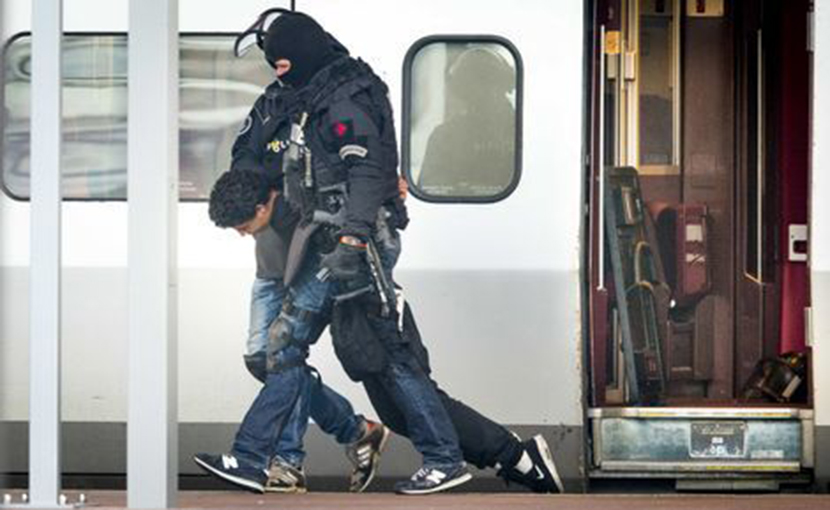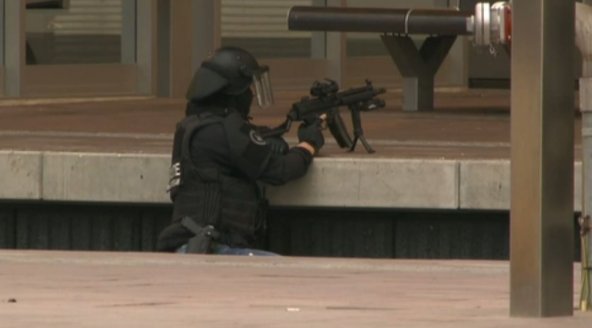
Another version has two French passengers wrestling with the gunman, with one of them shot and wounded during this altercation, and some Americans arriving on the scene later. El-Khazzani denied having any terrorist motive - his plan was to rob the passengers - and claims that he found the weapons abandoned in a suitcase in a park in Brussels.
Last Friday, another Thalys train 'came under attack', this time at a train station in the Dutch port city of Rotterdam. Right before the train was leaving Rotterdam, a 'man', as Dutch mainstream news sites reported, ran to the Thalys train, locked himself up in a toilet, and let it be known that he "had a bomb"... maybe, because this statement was never verified.
As a 'precaution', police officers and a heavily-armed 'SWAT' team arrived at the station, platforms 1-9 were cleared of people, a police helicopter was deployed, and a police dog was brought to the scene. At first, the man didn't want to make contact, but after nearly three hours, the officers got hold of him, brought him outside of the train, and arrested 'the man'... who turned out to be an adolescent:
In the video above, one of the SWAT officers appears to try to put a cap on the boy's head without success, as the boy struggles and soon afterwards collapses. The boy appears unable to move his legs. He is then dragged back into the train. Shortly after, an ambulance arrives and takes the boy, who was hyperventilating and in shock, to the hospital. No bombs were found on the train.
According to the suspect's lawyer, he is 16 years old and wanted to travel to France without paying for a ticket. There was no terrorist motive, said his lawyer. A recent Dutch news article reported that he appears to have nine different identities in European countries. He did not have an ID on him when the police removed him from the train. Dutch prosecutors say the suspect is a Tunisian who has been "roaming around in western Europe." The latest update is that he has been transferred to Dutch immigration custody.
Dutch citizen Marc Fauconnier recognized the boy from seeing him at the Rotterdam central train station the previous evening. Fauconnier was in a Thalys train headed for Brussels, which left shortly after 8pm from Amsterdam. He reported:
Once the train made a stop in Rotterdam, I saw a boy running in the train, chased after by a ticket inspector. The inspector then put him out of the train. When I see the boy now in these videos and images, that's who he reminds me of. I can't be completely sure, of course, but my immediate thought was: 'Oh, that's the boy from last night'. His face is alike, and the clothes he was wearing today were exactly the same as yesterday. But the inspector who put him out of the train would probably be able to recognize him even better. Last night, he was in a bit of a panic because he was being chased. But he definitely didn't look dangerous. I even felt sorry for him. He seemed desperate.Anti-Muslim hysteria
Similarities between the two Thalys attacks are striking: both suspects are young, homeless, immigrant men who do not speak the local language well and who locked themselves up in train toilets, and both have disavowed any terrorist motive. As is so often the case, it's the vulnerable who are manipulated and used to instill fear in people as part of the process of creating the 'new normal' of totalitarian, police states masquerading as Western democracies. Thalys has already begun training its personnel in 'identifying abnormal behavior' and in 'handling panic and crisis situations'. In addition, rail security will be tightened.
Where is Dutch society headed when an American-style paramilitary police invasion is being carried out to arrest and traumatise an unarmed and desperate 16-year-old 'fare-dodger'? The Dutch police state, like everywhere else in the Western world, needs fear to continue its expansion, while those in this country who stoke that fear roam free. As Dr. Martha Stout writes in her book the 'The Paranoia Switch', provoking fear in the minds of the people makes them more likely to demand 'protection' in the form of more draconian measures from those in positions of authority - those who constitute the real threat to the country, not the patsies used and abused in terror set-ups.
"In a democracy, a person displaying some or all of these behaviors would not be well tolerated under ordinary circumstances. Several of the ten characteristics [of fear brokers] are plainly unattractive and alienating. But, again, the behaviors are unattractive and alienating under certain conditions. Following a catastrophic national event, such as 9/11 in the United States, conditions are anything but ordinary. The people are traumatized, they long for someone to make them feel secure, and an ancient paranoia switch is once again waiting to snap on. Under these conditions, fear mongers thrive. Their characteristics are so hand in glove with the trauma reaction of the population that their identifying behaviors are scarcely "seen" at all. In short, after we have been thoroughly traumatized, we cannot see the devil." (p.186, The Paranoia Switch)In this most recent case, we are forced to accept the authorities' claim that the boy was transferred to immigration. Who will be able to check if the claim is true? Immigration and asylum centres in the 'civilized West' are dark and disturbing places. Not much is known about the comings and goings of people who get trapped in that system. It was reported that, in view of his physical and psychiatric condition, the authorities will decide what kind of 'help' the boy needs. Thinking back to the fate that awaited Toulouse Shootings patsy, Mohammed Merah, after he came into contact with French intelligence following misdemeanors as a teen, one shudders to think what might now happen to this young man.
And so another tragedy occurs in the Netherlands. Considering our 'colonial hangover', do we even need to ask whether this would have happened if the teen had been white?




I have got a heavy heart, because despite our violent past and present I love my country.
"One shudders to think what might now happen to this young man."
Indeed.